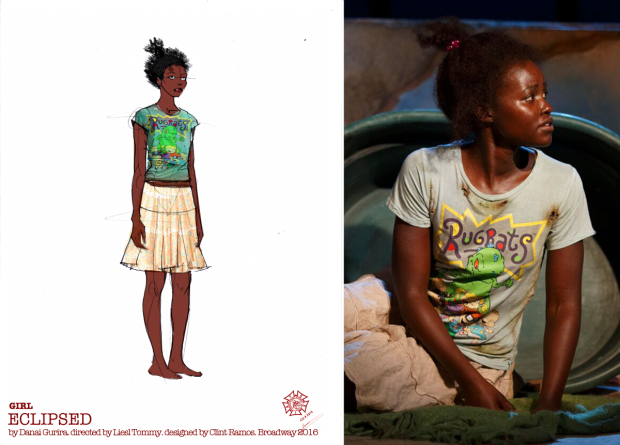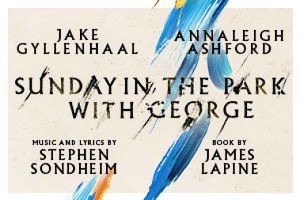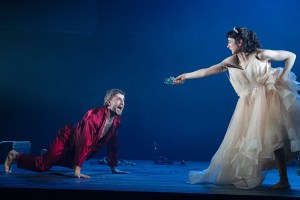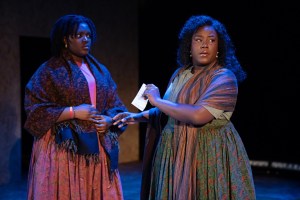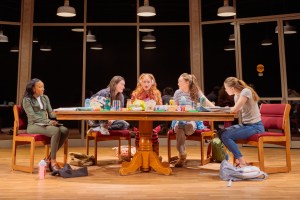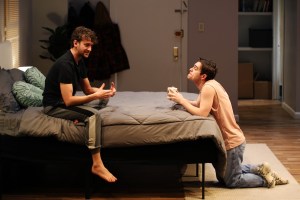How Clint Ramos Uses Color and Light to Costume Jake Gyllenhaal and More
Ramos is the Tony-winning designer behind ”Eclipsed”, ”Sunday in the Park With George”, ”Joan of Arc: Into the Fire”, and other new productions.
“I have tried very hard throughout my career not to have a style, to be as chameleonlike as possible,” says Tony Award winner Clint Ramos. “When I’m designing, I work very hard to find the maximum amount of truth onstage.”
This mission statement goes for every job that comes across Ramos’ desk, whether he’s envisioning Joan of Arc as a Kate Bush-style glam rock star or imagining a cramped but colorful hut belonging to a group of disenfranchised women during the Liberian Civil War.
These days, Ramos’ name is one that theatergoers are used to seeing quite often in their programs as both a costume and set designer. This season alone, the Philippines native is represented on Broadway with the costumes for In Transit, Sunday in the Park With George, and the upcoming Six Degrees of Separation. Off-Broadway, he has crafted the attire for David Byrne’s Joan of Arc: Into the Fire at the Public Theater and Hamish Linklater’s upcoming The Whirligig for the New Group, as well as the set for John Kander and Greg Pierce’s new musical Kid Victory at the Vineyard Theatre.
Regionally, his Tony-winning costumes for Eclipsed (as well as the set he designed for Danai Gurira’s drama) are currently being used in the San Francisco production at the Curran Theatre, while his Lortel Award-winning work on Byrne’s Here Lies Love will be seen in its upcoming Seattle Rep production. He’s also the scenic and costume designer for Billy Porter’s new production of Topdog/Underdog by Suzan-Lori Parks at the Huntington Theatre Company in Boston.
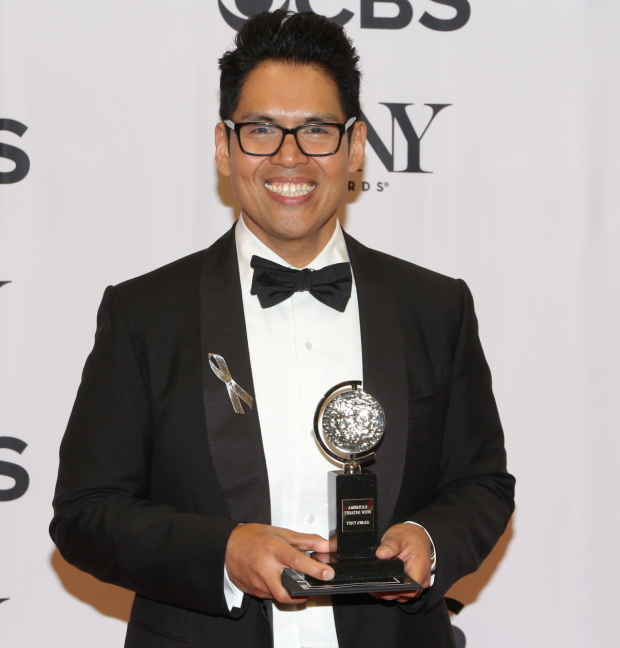
(© David Gordon)
Not bad for someone who didn’t really “set out to be a costume designer.” Coming from a family of lawyers, he says, “we never really saw the arts as a profession or a vocation, but my mother introduced us to the arts early on.” It was when he was in college, starting out pre-law, that he realized he needed to make a switch. “I double-majored in art and theater. I wanted to be a director originally, but I found that I was more adept in controlling things that didn’t talk back to me. I loved the idea that I could control the physical world and how that looked, and the inhabitants of the world and how they looked.”
Ramos received his MFA from New York University, which is where he came to the attention of George C. Wolfe, then the artistic director of the Public Theater. “George came and saw my work at the design show at NYU and invited me to design References to Salvador Dali Make Me Hot. The 2001 Public Theater production of Jose Rivera’s play launched Ramos’ career.
Since then, he’s become a sought-after designer throughout the country, often doubling up on set and costume design. “It all begins with a script and trying to find my way around,” Ramos notes about his process. “I form an emotional response to the piece and then I start looking at anything I can lay my eyes on and formulate an aesthetic for it. It’s about exposing myself to a lot of research, and digging in and getting lost. I just collect as much as I can.”
That was the case with Eclipsed, Gurira’s 2016 Tony-nominated drama about the five wives of a Liberian rebel group commanding officer during the war, a play for which Ramos did double duty. The Broadway premiere, and its Public Theater debut in late 2015, starred Oscar winner Lupita Nyong’o.
“I did not want to get that wrong,” Ramos recalls. “The only way I knew how to do it was to really get it right in photographic detail. The world knew how these women looked. There was so much journalistic evidence of that war. I was most nervous about presenting these women and there being an iota of falseness to them. It was a constant tug and pull of what I could present that would be relatable to an American audience and accurate to historical facts.”
One such example is a t-shirt worn by the leading character, The Girl, played on Broadway by Oscar winner Lupita Nyong’o. “The Rugrats T-shirt was truly a revelation,” he says regarding the outfit. “Liberia has a strong tie to America, and a lot of the clothing there is influenced by American discards. You will find these women wearing a traditional African skirt with, like, a bar mitzvah T-shirt from the ’80s. We auditioned so many T-shirts, and I found Rugrats on the Lower East Side at the Salvation Army. I put it on Lupita and she and I both gasped because it felt so right.” (All the research paid off in the form of Ramos’ first Tony Award for Best Costume Design of a Play.)
Accuracy was important — albeit, with a twist — when it came to the duds worn by Jake Gyllenhaal, Annaleigh Ashford, and the cast of Sunday in the Park With George at the Hudson Theatre. There was a bigger picture when it came to creating the costumes, Georges Seurat’s 1884 painting A Sunday Afternoon on the Island of La Grande Jatte, on which Stephen Sondheim and James Lapine’s Pulitzer-winning musical is based. But Ramos really attributes his more specific inspiration to “Seurat’s unrelenting search for modernity.”
For this production, directed by Sarna Lapine, Ramos wanted to blend the worlds of the past and the present, creating a look that was accurate to the original painting, though not necessarily period-specific. “I had this notion that maybe there was a way to do the show so that the costumes in the past [Act 1] and the costumes in the present [Act 2] were somehow the same, that people didn’t have to do a major costume change in order to jump back and forth,” he says.
As a result, “every item onstage is cut from modern patterns,” he says. “They don’t have any trim and don’t follow any sort of period rule. The women are not corseted, except for Annaleigh in the boudoir scene.” Similarly, the actors “don’t actually do a full change.” In the second half, “they remove a jacket or a hat, but they’re wearing the base costumes of the first act.”
When it came to color, though, his work was closely reminiscent of Seurat’s pointillistic techniques. As in the painting itself, “I purposefully didn’t include black in any of the costumes,” he says. “They’re either very deep browns or deep blues or deep reds. We perceive them as black.” Gyllenhaal’s two suits, which indeed look black to the naked eye, are black-red and black-blue. “It was about finding the blackest, reddest fabric I could find.” The fabrics themselves are blends of silk wool that “created this wonderful sheen that gives you depth theatrically.”
Ramos’ work on Joan of Arc at the Public similarly blurs the lines, with ideas inspired by suggestions from the show’s author, Talking Heads front man David Byrne. “He told me there are all these pop stars fascinated by Joan: Madonna, Kate Bush, and, to an extent, Beyoncé with all the metal work.” He also took inspiration from the show’s leading cast member, Jo Lampert. “Here’s this creature who almost defies gender, which is so appropriate for Joan, or at least where Joan ends up,” he says of Lampert. “It was about, how can I make this unicorn be this rock star? We used a lot of leather, a lot of soft surfaces, to play with the feminine-masculine forces that are already in play in the musical and her persona.”
What he calls magical about the Joan of Arc experience really plays into all of his work. “We are forced to look at the past in order to ensure our future, and make sense of what’s happening in the present,” he says. Ultimately, this idea plays into his search for truth and his desire to trust that the audience will follow along. “The audience knows what’s false and what’s true. That goes visually as well as for the performers. If we give the audience enough clues, they will assemble it themselves.”
(Costume sketches provided by Clint Ramos; production photos by Joan Marcus and Matthew Murphy)

